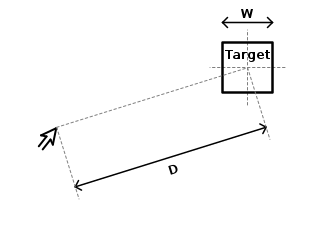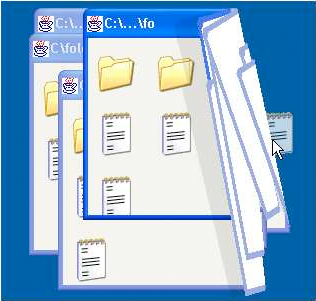Related Research Articles

Fitts's law is a predictive model of human movement primarily used in human–computer interaction and ergonomics. This scientific law predicts that the time required to rapidly move to a target area is a function of the ratio between the distance to the target and the width of the target. Fitts's law is used to model the act of pointing, either by physically touching an object with a hand or finger, or virtually, by pointing to an object on a computer monitor using a pointing device.

A scrollbar is an interaction technique or widget in which continuous text, pictures, or any other content can be scrolled in a predetermined direction on a computer display, window, or viewport so that all of the content can be viewed, even if only a fraction of the content can be seen on a device's screen at one time. It offers a solution to the problem of navigation to a known or unknown location within a two-dimensional information space. It was also known as a handle in the very first GUIs. They are present in a wide range of electronic devices including computers, graphing calculators, mobile phones, and portable media players. The user interacts with the scrollbar elements using some method of direct action, the scrollbar translates that action into scrolling commands, and the user receives feedback through a visual updating of both the scrollbar elements and the scrolled content.
In human–computer interaction and user interface design, cut, copy, and paste are related commands that offer an interprocess communication technique for transferring data through a computer's user interface. The cut command removes the selected data from its original position, while the copy command creates a duplicate; in both cases the selected data is kept in temporary storage. The data from the clipboard is later inserted wherever a paste command is issued. The data remains available to any application supporting the feature, thus allowing easy data transfer between applications.

Usability can be described as the capacity of a system to provide a condition for its users to perform the tasks safely, effectively, and efficiently while enjoying the experience. In software engineering, usability is the degree to which a software can be used by specified consumers to achieve quantified objectives with effectiveness, efficiency, and satisfaction in a quantified context of use.
In computing and telecommunications, a menu is a list of options or commands presented to the user of a computer or communications system. A menu may either be a system's entire user interface, or only part of a more complex one.

A graphical widget in a graphical user interface is an element of interaction, such as a button or a scroll bar. Controls are software components that a computer user interacts with through direct manipulation to read or edit information about an application. User interface libraries such as Windows Presentation Foundation, GTK, and Cocoa, contain a collection of controls and the logic to render these.
The following outline is provided as an overview of and topical guide to human–computer interaction:
GOMS is a specialized human information processor model for human-computer interaction observation that describes a user's cognitive structure on four components. In the book The Psychology of Human Computer Interaction. written in 1983 by Stuart K. Card, Thomas P. Moran and Allen Newell, the authors introduce: "a set of Goals, a set of Operators, a set of Methods for achieving the goals, and a set of Selections rules for choosing among competing methods for goals." GOMS is a widely used method by usability specialists for computer system designers because it produces quantitative and qualitative predictions of how people will use a proposed system.
In human–computer interaction, the keystroke-level model (KLM) predicts how long it will take an expert user to accomplish a routine task without errors using an interactive computer system. It was proposed by Stuart K. Card, Thomas P. Moran and Allen Newell in 1980 in the Communications of the ACM and published in their book The Psychology of Human-Computer Interaction in 1983, which is considered as a classic in the HCI field. The foundations were laid in 1974, when Card and Moran joined the Palo Alto Research Center (PARC) and created a group named Applied Information-Processing Psychology Project (AIP) with Newell as a consultant aiming to create an applied psychology of human-computer interaction. The keystroke-level model is still relevant today, which is shown by the recent research about mobile phones and touchscreens.
Stuart K. Card, an American researcher and retired Senior Research Fellow at Xerox PARC, is considered to be one of the pioneers of applying human factors in human–computer interaction. His study of input devices led to the Fitts's Law characterization of the computer mouse and was a major factor leading to the mouse's commercial introduction by Xerox, most notably in the Alto and Star projects, some of the very earliest GUI systems employing a desktop metaphor. The 1983 book The Psychology of Human-Computer Interaction, which he co-wrote with Thomas P. Moran and Allen Newell, became seminal work in the HCI field. Further research into the theoretical characterizations of human–machine interaction led to developments like "the Model Human Processor, the GOMS theory of user interaction, information foraging theory, and statistical descriptions of Internet use". In the new millennium his research has been focusing on developing a "supporting science of human–information interaction and visual-semantic prototypes to aid sense making".
Thomas P. Moran is a Distinguished Engineer at the IBM Almaden Research Center in San Jose, California. He has been active in the field of human computer interaction for a very long time. In 1983 the book he wrote along with Stuart Card and Allen Newell The Psychology of Human-Computer Interaction was published. It became a very influential book in the field, partly for introducing the Goals, Operators, Methods, and Selection rules (GOMS) model.
Human processor model or MHP is a cognitive modeling method developed by Stuart K. Card, Thomas P. Moran, & Allen Newell (1983) used to calculate how long it takes to perform a certain task. Other cognitive modeling methods include parallel design, GOMS, and keystroke-level model (KLM).
The Windows shell is the graphical user interface for the Microsoft Windows operating system. Its readily identifiable elements consists of the desktop, the taskbar, the Start menu, the task switcher and the AutoPlay feature. On some versions of Windows, it also includes Flip 3D and the charms. In Windows 10, the Windows Shell Experience Host interface drives visuals like the Start Menu, Action Center, Taskbar, and Task View/Timeline. However, the Windows shell also implements a shell namespace that enables computer programs running on Windows to access the computer's resources via the hierarchy of shell objects. "Desktop" is the top object of the hierarchy; below it there are a number of files and folders stored on the disk, as well as a number of special folders whose contents are either virtual or dynamically created. Recycle Bin, Libraries, Control Panel, This PC and Network are examples of such shell objects.

In computing, the trash is temporary storage for files that have been deleted in a file manager by the user, but not yet permanently erased from the file system. Typically, a recycle bin is presented as a special file directory to the user, allowing the user to browse deleted (removed) files, undelete those that were deleted by mistake, or delete them permanently.
NGOMSL is a variation of the GOMS technique in human computer interaction.
CPM-GOMS is a variation of the GOMS technique in human computer interaction. CPM-GOMS stands for two things: Cognitive Perceptual Motor and the project planning technique Critical Path Method.
In computing, the icon bar is the name of the dock in Acorn's RISC OS operating system, and is fundamental to the OS. Its introduction in 1987 was a new concept in GUIs. It displays icons through which access is provided to all parts of the computer that a typical user will require, from physical devices and system utilities to running applications, and will usually be their starting point for interacting with the system once it has finished booting.

An interaction technique, user interface technique or input technique is a combination of hardware and software elements that provides a way for computer users to accomplish a single task. For example, one can go back to the previously visited page on a Web browser by either clicking a button, pressing a key, performing a mouse gesture or uttering a speech command. It is a widely used term in human-computer interaction. In particular, the term "new interaction technique" is frequently used to introduce a novel user interface design idea.
Human performance modeling (HPM) is a method of quantifying human behavior, cognition, and processes; a tool used by human factors researchers and practitioners for both the analysis of human function and for the development of systems designed for optimal user experience and interaction. It is a complementary approach to other usability testing methods for evaluating the impact of interface features on operator performance.
References
Notations
- This article incorporates text from Dr. G. Abowd: GOMS Analysis Techniques - Final Essay, which has been released into GFDL by its author).
Footnotes
- ↑ Card, Stuart; Thomas P. Moran; Allen Newell (1983). The Psychology of Human Computer Interaction . Lawrence Erlbaum Associates. ISBN 0-89859-859-1.